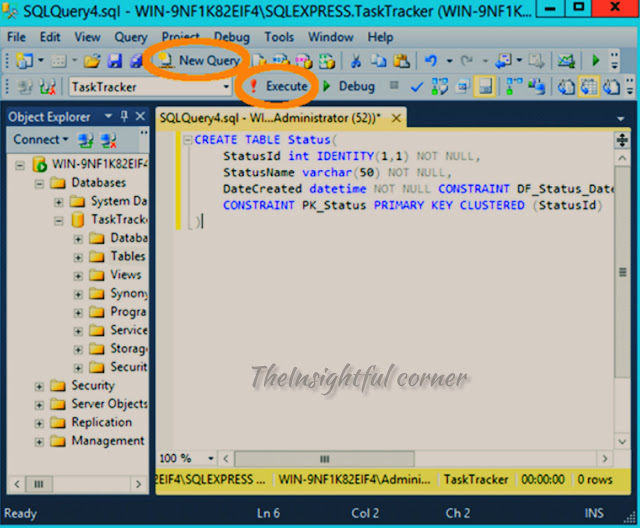How to Create a Table in SQL
SQL Table Creation: A Step-by-Step Guide for Beginners
Relational databases are managed and worked on using the robust language SQL (Structured Query Language). One of the fundamental operations in SQL is creating tables, which act as containers for organizing and storing data.The process of building tables in SQL will be covered in this article, along with the essential syntax and procedures.
Understanding SQL Tables
What is SQL?
Relational databases are managed and queried using SQL, a standardised language.Users may define, modify, and retrieve data from the database using this tool.It allows users to define, manipulate, and retrieve data from the database. SQL databases are widely used in various industries, ranging from e-commerce to finance, to store and retrieve structured data efficiently.
What are SQL tables?
The basic structure of a relational database are SQL tables.A table represents a collection of related data organized into rows and columns.In a table, each row denotes a record, and each column denotes a particular property or field of that record.By creating tables, you define the structure and layout for storing data in your database.
Creating a Table
Syntax for table creation
You must use the 'construct TABLE' command, followed by the table name and column definitions, to construct a table in SQL.The basic syntax for creating a table is as follows:
```sql
CREATE TABLE table_name (
column1 datatype constraints,
column2 datatype constraints,
...
);
```
Specifying column names and data types
You must define the column names and associated data types when building a table.
The type of data that may be put in a certain column—such as integers, texts, dates, or floating-point numbers—depends on the data type.Additionally, you can define constraints to enforce specific rules or conditions on the data in a column, such as uniqueness or non-nullability.
Defining constraints
The consistency and integrity of the data in a table are kept up by constraints.Common constraints include:
- Primary Key: Ensures the uniqueness of a column's values within a table.
- Foreign Key: Establishes relationships between tables by referencing the primary key of another table.
- Not Null: Specifies that a column must have a non-null value.
- Unique: Ensures the uniqueness of values in a column.
- Check: Defines custom conditions that the data in a column must meet.
Example table creation
Let's establish a straightforward table called "Users" to house user data.The table will have columns for ID, name, email, and age.An illustration of a SQL query to construct this table is shown below:
```sql
CREATE TABLE Users (
ID INT PRIMARY KEY,
Name VARCHAR(50) NOT NULL,
Email VARCHAR(100) UNIQUE,
Age INT CHECK (Age >= 18)
);
```
Four columns make up this example's table: ID (integer), Name (string), Email (string), and Age (integer). The ID column is defined as the primary key, ensuring uniqueness. The Name column is marked as not null, and the Email column has a uniqueness constraint. The Age column has a check constraint to ensure the age is 18 or higher.
Modifying a Table
Adding columns
An existing table can be changed in SQL by the addition of additional columns.The 'ADD COLUMN' clause of the 'ALTER TABLE' statement can be used to do this.
Here's an example:
```sql
ALTER TABLE Users
ADD COLUMN City VARCHAR(50);
```
This example changes the "Users" table's existing "City" field.
Modifying column data types
A table's column's data type may occasionally need to be changed.
Using the 'ALTER TABLE' statement and the 'ALTER COLUMN' clause, this may be accomplished.
Here's an example:
```sql
ALTER TABLE Users
ALTER COLUMN Age DECIMAL(5, 2);
```
In this illustration, the "Age" column's data type is changed from an integer to a decimal with a precision of 5 and a scale of 2.
Renaming a table
Use the 'ALTER TABLE' statement with the 'RENAME TO' clause in SQL to rename an existing table.
Here's an example:
```sql
ALTER TABLE Users
RENAME TO Customers;
```
In this example, we rename the "Users" table to "Customers".
Dropping a Table
A table in your database can be deleted with the 'DROP TABLE' statement if you no longer require it.Be cautious when using this statement, as it permanently deletes the table and its associated data.
Here's an example:
```sql
DROP TABLE Customers;
```
In this example, the "Customers" table is dropped from the database.
Conclusion
Anyone working with relational databases must be able to create and manage tables in SQL.Tables provide a structured and organized way to store data, enabling efficient data retrieval and manipulation. By understanding the syntax and techniques for table creation, modification, and deletion, you can effectively design and maintain your database schema.
FAQs
1. Can I create multiple tables in a single SQL statement?
No, each table must be created using a separate `CREATE TABLE` statement.
2. What happens if I try to create a table with an existing name?
An error will be raised if you try to create a table with a name that already exists in the database.
3. Can I change the name of a column in an existing table?
Yes, you may modify a column's name using the 'RENAME COLUMN' clause and the 'ALTER TABLE' statement.
4. Are there any limitations on the number of columns in a table?
Your database management system may have a limit on the amount of columns that may be in a table.Most modern database systems support a large number of columns per table.
5. How can I delete all the data from a table without dropping the table itself?
The 'DELETE FROM' command may be used to completely delete all the data from a table while preserving the database's structure.








No comments: